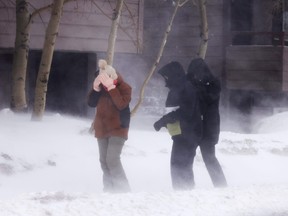
Article content
RENO, Nev. — California authorities shut down 100 miles of Interstate 80 on Friday as the biggest snow storm of the season bore down on the Sierra Nevada, where residents were urged to take shelter and stay off roads as they prepared for up to 10 feet of snow in some areas and damaging winds.
Advertisement 2
Article content
“AAANNNDD WE’RE CLOSED!!” the California Highway Patrol posted on X, previously known as Twitter, saying the closure was due to “spin outs, high winds, and low visibility. No estimated time of reopening the freeway.”
Article content
Authorities closed the interstate in both directions after 5 p.m. on a day when the majority of more than a dozen ski resorts around Lake Tahoe were closed and visitors to Yosemite National Park were told to leave. The 160-kilometre closure is at the state border just west of Reno, Nevada to near Emigrant Gap, California.
California Highway Patrol, state transportation officials and other authorities reported throughout the day that troopers and others were responding to dozens of collisions on I-80, cars sliding into snow banks or getting stuck on the side of slick roadways. There were no immediate reports of any serious injuries.
Article content
Advertisement 3
Article content
The National Weather Service in Reno said late Friday it expects the heaviest snow to arrive after midnight, continuing with blizzard conditions and blowing snow through Saturday that could reduce visibility to one-quarter mile or less.

The storm began barreling into the region on Thursday, with the biggest effects expected to close major highways and trigger power outages Friday afternoon into Saturday. A blizzard warning through Sunday morning covers a 482-kilometre stretch of the mountains.
Rick Grundy, manager of the Chevron Food Mart near Donner Lake just off Interstate 80, said business was slow Friday — people seemed to have taken officials’ advice to hunker down. After living in the Truckee, California, area for 20 years, he said he knows how to prepare for bad weather.
Advertisement 4
Article content
“We’re pretty well stocked. We knew this was coming,” Grundy said. “One thing I’ve learned, if you are not used to driving in this weather, if you’re not used to being in this area, it’s not a good idea. You should stay home.”
Meteorologists predict as much as 10 feet (3 metres) of snow is possible in the mountains around Lake Tahoe by the weekend, with 3 to 6 feet (0.9 to 1.8 metres) in the communities on the lake’s shores and more than a foot (30 centimetres) possible in the valleys on the Sierra’s eastern front, including Reno.
Winds are expected to gust in excess of 185 km/h over Sierra ridgetops, and 113 km/h at lower elevations.
Backcountry avalanche warnings were in place in various areas. All visitors at Yosemite were supposed to be out as of noon Friday, with the park closed at least through noon Sunday. More than 7 feet (2.13 metres) of snow could fall in some areas.
Advertisement 5
Article content
Many Lake Tahoe ski resorts said they were staying closed Friday due to conditions.
But the snow wasn’t all bad news for the resorts. Palisades Tahoe ski resort said the big dump expected over the weekend on top of 8 feet (2.4 metres) of snow in February should allow them to keep the slopes open through Memorial Day.
In South Lake Tahoe, the lunchtime crowd at Heidi’s Pancake House was a third of the typical 60 diners. Even with the worsening forecast, general manager Salvador Ortega expected to stay open and most of his employees to show up.
“We are one of the restaurants in South Lake Tahoe that don’t close unless we don’t have power or something breaks down. We’re open 365,” he said. “Tahoe is a small community. It’s rare when an employee doesn’t make it to work.”
Advertisement 6
Article content
Ortega said he believes the snowfall will ultimately be good for the community and increase tourism once it’s safe to travel again.
Andrew Schwartz, the lead scientist at UC-Berkeley’s Central Sierra Snow Lab, said it is possible they could break their modern-day record of about 3.5 feet (1 metre) of snow in a single day from back in 1989.
On the bright side, California water officials said the storm should provide a much-needed boost to the Sierra snowpack, which is vital to the state’s water supplies. It stood at 80% of average to date on Thursday, California Department of Water resources officials said.
Todd Cummings decided to drive from Santa Cruz to the Lake Tahoe area ahead of the storm. His destination, the Northstar resort, did open, but the slopes were far from packed.
“Nobody’s here,” he said in a brief phone interview during his first chairlift ride of the day. “They have limited trails open but this lift goes to the top.”
— Dazio reported from Los Angeles. Associated Press reporters John Antczak in Los Angeles and Olga Rodriguez in San Francisco contributed to this report.
Article content



